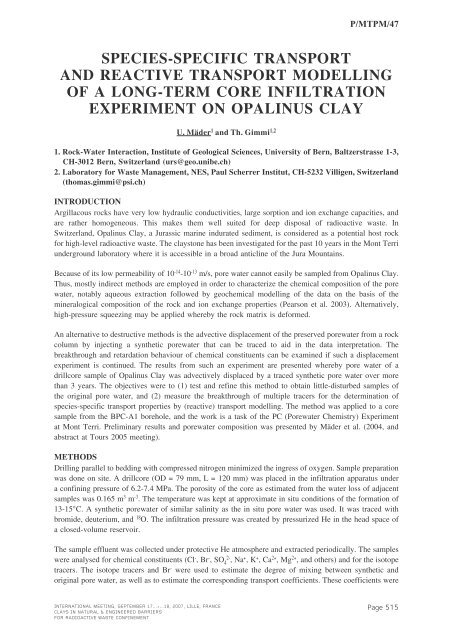Mass Transfer & Porous Media (MTPM) - Andra
Mass Transfer & Porous Media (MTPM) - Andra
Mass Transfer & Porous Media (MTPM) - Andra
Create successful ePaper yourself
Turn your PDF publications into a flip-book with our unique Google optimized e-Paper software.
P/<strong>MTPM</strong>/47SPECIES-SPECIFIC TRANSPORTAND REACTIVE TRANSPORT MODELLINGOF A LONG-TERM CORE INFILTRATIONEXPERIMENT ON OPALINUS CLAYU. Mäder 1 and Th. Gimmi 1,21. Rock-Water Interaction, Institute of Geological Sciences, University of Bern, Baltzerstrasse 1-3,CH-3012 Bern, Switzerland (urs@geo.unibe.ch)2. Laboratory for Waste Management, NES, Paul Scherrer Institut, CH-5232 Villigen, Switzerland(thomas.gimmi@psi.ch)INTRODUCTIONArgillacous rocks have very low hydraulic conductivities, large sorption and ion exchange capacities, andare rather homogeneous. This makes them well suited for deep disposal of radioactive waste. InSwitzerland, Opalinus Clay, a Jurassic marine indurated sediment, is considered as a potential host rockfor high-level radioactive waste. The claystone has been investigated for the past 10 years in the Mont Terriunderground laboratory where it is accessible in a broad anticline of the Jura Mountains.Because of its low permeability of 10 -14 -10 -13 m/s, pore water cannot easily be sampled from Opalinus Clay.Thus, mostly indirect methods are employed in order to characterize the chemical composition of the porewater, notably aqueous extraction followed by geochemical modelling of the data on the basis of themineralogical composition of the rock and ion exchange properties (Pearson et al. 2003). Alternatively,high-pressure squeezing may be applied whereby the rock matrix is deformed.An alternative to destructive methods is the advective displacement of the preserved porewater from a rockcolumn by injecting a synthetic porewater that can be traced to aid in the data interpretation. Thebreakthrough and retardation behaviour of chemical constituents can be examined if such a displacementexperiment is continued. The results from such an experiment are presented whereby pore water of adrillcore sample of Opalinus Clay was advectively displaced by a traced synthetic pore water over morethan 3 years. The objectives were to (1) test and refine this method to obtain little-disturbed samples ofthe original pore water, and (2) measure the breakthrough of multiple tracers for the determination ofspecies-specific transport properties by (reactive) transport modelling. The method was applied to a coresample from the BPC-A1 borehole, and the work is a task of the PC (Porewater Chemistry) Experimentat Mont Terri. Preliminary results and porewater composition was presented by Mäder et al. (2004, andabstract at Tours 2005 meeting).METHODSDrilling parallel to bedding with compressed nitrogen minimized the ingress of oxygen. Sample preparationwas done on site. A drillcore (OD = 79 mm, L = 120 mm) was placed in the infiltration apparatus undera confining pressure of 6.2-7.4 MPa. The porosity of the core as estimated from the water loss of adjacentsamples was 0.165 m 3 m -3 . The temperature was kept at approximate in situ conditions of the formation of13-15°C. A synthetic porewater of similar salinity as the in situ pore water was used. It was traced withbromide, deuterium, and 18 O. The infiltration pressure was created by pressurized He in the head space ofa closed-volume reservoir.The sample effluent was collected under protective He atmosphere and extracted periodically. The sampleswere analysed for chemical constituents (Cl - , Br - , SO 4 2- , Na + , K + , Ca 2+ , Mg 2+ , and others) and for the isotopetracers. The isotope tracers and Br - were used to estimate the degree of mixing between synthetic andoriginal pore water, as well as to estimate the corresponding transport coefficients. These coefficients wereINTERNATIONAL MEETING, SEPTEMBER 17...>...18, 2007, LILLE, FRANCECLAYS IN NATURAL & ENGINEERED BARRIERSFOR RADIOACTIVE WASTE CONFINEMENTPage 515
















